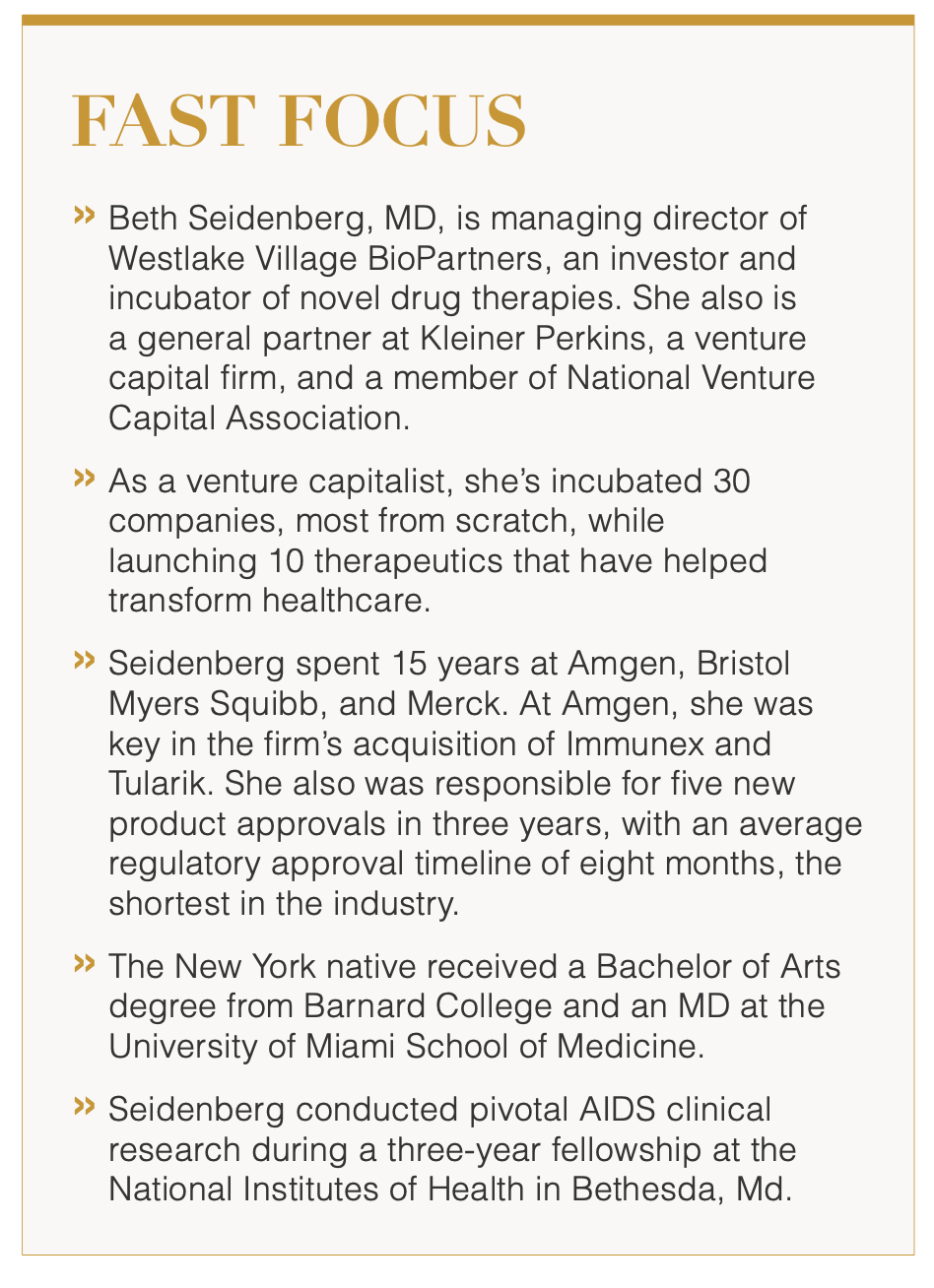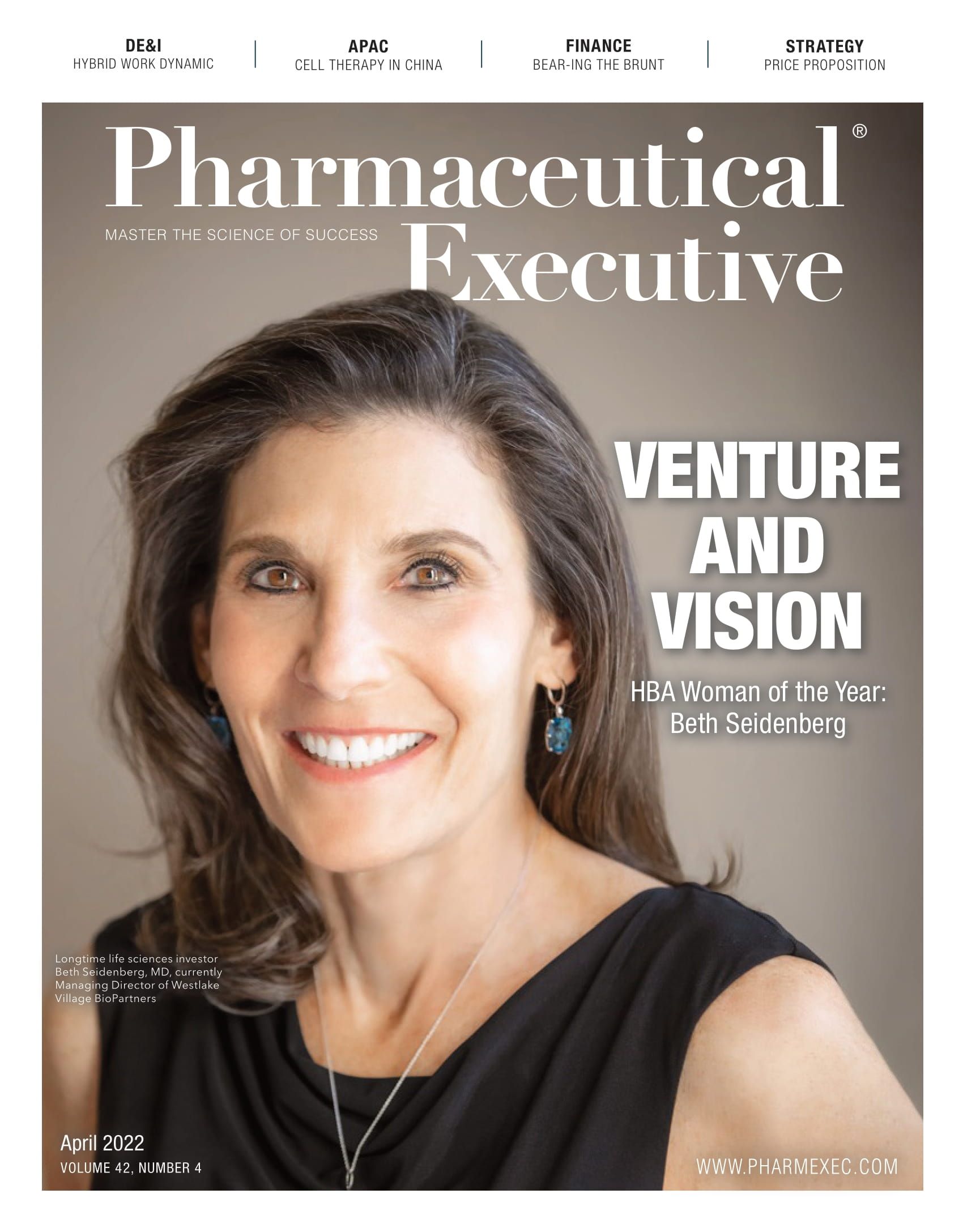A Dogged Devotion
Saving and transforming as many patients’ lives as possible has been the driving force behind Beth Seidenberg’s audacious career, where she has excelled as a doctor, researcher, and venture capitalist.

While working at the National Institutes of Health (NIH), Beth Seidenberg, MD, faced what seemed an impossible task: finding a novel approach to treat the then-devastating disease of AIDS. “People were dying right and left, and we didn’t know the instigator or have the therapeutics to treat it,” she says.
But she and the clinical team at NIH performed the original clinical trials for AZT (azidothymidine), a drug still used today to prevent and treat AIDS. “That opened my eyes to impacting patients not just one at a time, but tens of thousands to a million at a time,” says Seidenberg, named the Healthcare Businesswomen’s Association’s (HBA) 2022 Woman of the Year. “For me, it’s always been about patients. And I’ve been able to help on a scale I’d never dreamed.”
Since her fellowship at NIH’s National Institutes of Allergy and Infectious Diseases from 1986–1989, Seidenberg’s career has been marked not only by talent and skill, but by energy, decisiveness, daring, attention to detail, calm during chaos, and high expectations of herself, yet with an ability to roll with any setbacks.
“She burns with an innate drive to change the world,” says Sean Harper, MD, a colleague for 27 years who, like her, is co-founding managing director of Westlake Village BioPartners, an incubator of life-saving drugs in Thousand Oaks, Calif.
Moving from medicine and academia (briefly) to pharmaceutical giants Merck, Amgen, and Bristol Myers Squibb (BMS), Seidenberg has been a generalist, working on therapies to fight asthma, cancer, diabetes, neurodegenerative disorders, chronic obstructive pulmonary disease, infertility, and a wide range of rare maladies.
“Cutting-edge medicine is happening in small companies, not big pharma,” says Harper of Seidenberg’s move into venture capital, first at Kleiner Perkins Caufield & Byers in 2005. “To be knowledgeable about the talent, medical technology, and investing/business side of things is very rare. She has tremendous experience forming companies from scratch—30 thus far.”
She’s also launched 10 major therapeutic approaches spanning a broad spectrum of ailments, from cancer (Tesaro) to infertility (Progyny) to delivering care for diabetes and other chronic diseases (Livongo). At Amgen alone, she was responsible for five new product approvals in three years—and the briefest average regulatory approval timeline in the industry, eight months.
“You couldn’t construct a more perfect resume to be a venture capitalist in the biosciences,” says Brook Byers, a partner at venture capital firm Kleiner Perkins. “She built her career brick by brick.”
Yet as Seidenberg says, “Only my initial decision to train as a physician was intentional. Anything else was by virtue of keeping an open mind and an open door to opportunities.” That’s the message of a treasured paperweight on her desk: “If a door opens, walk through it.”
When she approached Harper about launching their own venture capital firm in 2018, he quickly accepted, despite a comfortable perch at Amgen. “A huge part of taking the leap was my admiration for Beth,” says Harper, who’d worked with Seidenberg at Merck and went to Amgen in part to work with her. “I knew she’d do everything possible to succeed. She’s always been a force of nature, with a remarkably consistent work ethic and focus. She never lets up.”
In the three-and-a-half years since, Westlake has raised $820 million to nurture entrepreneurs of new bioscientific therapies to cure rare yet ruinous diseases.
Opportunity knocks

The first door to open for Seidenberg was at Montefiore Hospital in the Bronx, N.Y. As a child, she stood on a stool to peer into the operating room of cardiac surgeon and chief of surgery Bernard Seidenberg, her father. Like her, he broke ground, with his research and technique to perform the first end-to-end anastomosis of blood vessels.
“My dad taught me and my sisters you can do anything and be anything you want, and if you work hard, good things will come your way,” says Seidenberg. “He inspired me to be a doctor and give back. I’ve carried on in his footsteps, and I’ve kept his name. That was important to me and to him.”
Like her sisters, she attended a private girls’ university—in her case, Manhattan’s Barnard College, where she double-majored in biology and anthropology. She published her first scientific paper, on animal behavior, during her senior year in 1979.
While she was at the University of Miami School of Medicine, Dean John K. Robinson, MD, supported her talent as a researcher. “I’ve had incredible mentors and champions who helped me to succeed,” Seidenberg says.
Seidenberg’s NIH fellowship work drew the attention of pharmaceutical firms, including Merck and executive vice president Reynold Spector—“still my mentor and dear friend,” she says. Like many since, he was impressed by her dogged devotion to work, and he offered her a gutsy proposition: Join him at Merck rather than enter academia, a more traditional move. “He said, ‘You could publish papers, but I will teach you how to develop drugs. Together we can impact many more lives,’” she recalls. “Thus began chapter two of my unexpected career.”
Within a decade, Seidenberg rose from Merck’s associate director of clinical pharmacology to vice president of pulmonary immunology. In 2000, she joined BMS, rising from vice president to senior vice president of global development. From 2002–2004, she was chief medical officer at Amgen.
While in the industry, her goal was to create novel therapies to achieve what no other medicine had. “I’m super proud of the products I launched during my industry tenure,” says Seidenberg, who remains a general partner at Kleiner Perkins.
She also has remained a perpetual student. She says she loves learning and following new opportunities because it keeps life interesting. “While others read novels on weekends, Beth reads medical journals and science magazines,” says Byers. “She’s addicted to her iPad.”
Like Byers, Harper notes how often Seidenberg works late into the night and on weekends. “She’s passionate about what she does,” he says.
Byers met Seidenberg in 2005 after Amgen board members spoke of a remarkable, talented person who wanted to become a venture capitalist in biopharma. “I was blown away,” he says. “Beth has all the tools for a great venture capital investor and company founder.” That includes her skill to secure financing and receive approval from FDA and the medical community. “She’s a great recruiter who finds the best people and coaches them to play well together, while working shoulder-to-shoulder with them,” he adds
Seidenberg recalls Byers commenting that venture capital is a helping profession. “That resonated,” she says. “It’s in my DNA to inspire, nurture, and support entrepreneurs and the teams they build.”
Dream big, plan ahead
Byers marvels at Seidenberg’s fearless funding of scientists who have a good idea but no research or development plan. Yet Seidenberg sees it differently. “It’s a calculated risk,” she says. “You don’t jump off a cliff without a parachute. But if you have a parachute and are trained, you might take that risk.”
Having been a doctor has helped her to be decisive. “Developing therapeutics is not for the faint of heart,” she says. “There will be bumps in the road. But I always have a plan B.”
Seidenberg recalls John Doerr (at Kleiner Perkins) asking how she stays calm. Her answer came from a colleague’s advice decades ago: “He said, ‘Take your own pulse first, calm down, get yourself grounded, and then you can see the patient,’” she says. “I still do that anytime I have a problem.”
Not only is Seidenberg unflappable, but she’s excited by complex challenges, while giving reassurance not only to investors but also to scientists at Westlake’s startups, Harper says. She often ends emails with “Onward!”
Nancy Stagliano, CEO of Neuron23—a developer of precision drugs for neurological and immunological diseases—has worked with Seidenberg at three companies over the past 14 years. “She’s able to see around corners to anticipate and head off challenges before they arrive,” Stagliano says. “During setbacks, she’s deployed her vast network to bring in people to support me and my companies. Not every investor works as rapidly and constructively as she does. And she gives her full attention, recalling details from conversations even months earlier.”
Few investors are as invested emotionally, Stagliano adds. “When receiving good news or data—she loves data—her rallying cry is ‘Go, go, go!’ She wants you to keep moving.”
Seidenberg’s track record also opens doors for those she champions.“Other venture capitalists and Big Pharma recognize she has an exquisite ability to build strong, high-value companies to public markets or pharmaceutical partners,” Stagliano says.
That’s why Byers became the first personal investor in Westlake, committing as Seidenberg told him about her plans. “She’s bold and doesn’t try small things,” he says. “I never doubted she’d succeed.”
In 2020, GlaxoSmithKline bought Tesaro for $5.1 billion. “As [Beth] likes to say, her companies are ‘bought up, not sold,’” says Harper. “When you build a quality company, they come and buy it. You don’t sell it.”
A passion for winning
“One of Beth’s greatest strengths—holding herself to a superhuman standard of work ethic and focus—can be a problem,” says Harper. “She holds everyone else to that standard, but not everyone can perform at that level. Some thrive. Others find it intimidating. She’s become more aware of it and tries to temper it.”
In her effort to attain excellence, “she’s always looking to the next level of achievement and success,” Byers adds. “She makes big, gutsy jumps, leaving behind security.”
Even in recreation, Seidenberg demands the best of herself. “There’s nothing more invigorating than getting on a bike and challenging yourself to ride faster, ride better,” she says. “I’ve always loved athletic pursuits.”
When she arrived in Thousand Oaks, Calif., Seidenberg was determined to conquer Mulholland Highway’s Rock Store cycling climb for its steepness (500 feet in 2.6 miles) or Snake route for its sharp turns. Thanks to a friend and former Amgen colleague who helped her train, she was able to achieve both. “Now I can climb anything,” she says.
Seidenberg rides alone for up to three hours at a time. “I tell my husband I’m going for my therapy session,” she says. “The fresh air and mountains give me clarity when I have a problem to solve.”
She also loves the Greater Los Angeles Area’s diversity, from industry people to culture and talent. “We have a tremendous talent pool in LA of executives, scientists, clinicians, and academics,” says Seidenberg. “Add a receptive local government and real estate, and we have the perfect foundation for success.”
Tapping into that local talent, Westlake has already added hundreds of new jobs, including a number of scientists from across the US and Europe, too. The firm recently hired “rising star” and LA native Mira Chaurushiya, PhD, as a senior partner. Like Harper and Seidenberg, she has experience in novel biopharma products. “If we help other women and minorities to achieve their dreams, we will change the demographics of this field,” says Chaurushiya.
Seidenberg’s ambition might make her appear to be a hard-nosed executive, but that couldn’t be further from the truth, contends Harper. Her eye for detail translates into her personal life in a positive way. “She remembers everyone’s birthdays, always shows up with gifts, and at the holidays takes my daughters to see a show,” he says.
This warmth, in addition to her professional loyalty, has kept talented colleagues in her circle for decades. “She’s an incredibly kind and caring individual who always asks first how you and your family are before diving into business,” adds Stagliano.
At Kleiner Perkins—where Seidenberg worked from 2005–2018—people heeded a sign on her desk, “The doctor is in, 5 cents,” and often would seek her input on a variety of medical matters. “Everybody in our firm—60 people—would drop by if anyone in their family was sick and ask her advice,” Byers recalls. “She’d say, ‘I’m not a practicing doctor, but perhaps you should talk to someone in this specialty.’ She was our in-house medical consultant, helping everybody, respecting their privacy—and never charging us.”
Beth Seidenberg enjoying time with her Cavalier King Charles spaniels, Mattie and Reese.

Byers misses not only those sessions, but also the Jewish high holidays. “Every year, she’d cook brisket and kugel (a sweet noodle dish) for everybody at the firm,” he says. “I always told her to give me a heads-up so I wouldn’t eat that morning.”
Seidenberg also shows her soft side when it comes to her beloved Cavalier King Charles spaniels, Mattie, 12, and Reese, 3, named after her love for the candy. “I adore them, and they love me, too—though when my [Westlake] partner Desmond [Padhi] shows up, I’m chopped liver, as they say.”
Whether at work or at play, Seidenberg’s unique mix of hard and soft skills lends to her success. “I hope Westlake becomes a leading brand,” she says. “That would be a great legacy, and I could pay back the generosity and incredible privilege I’ve had in my career.”
Michele Meyer is a freelance profile and medical writer. She is based in Houston, Texas.
